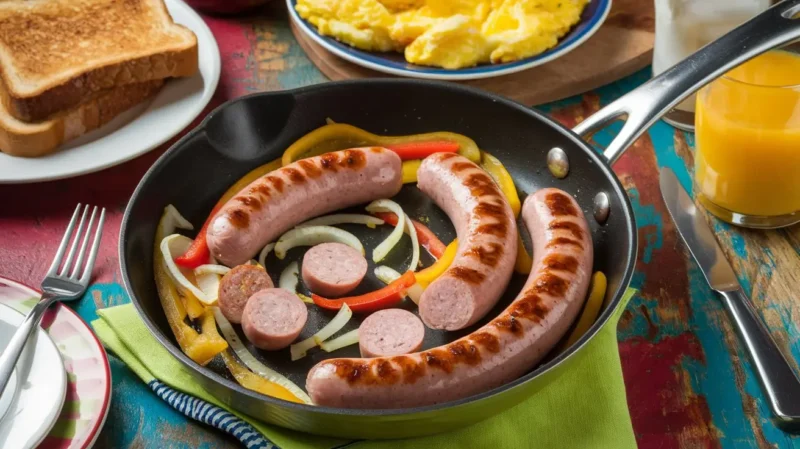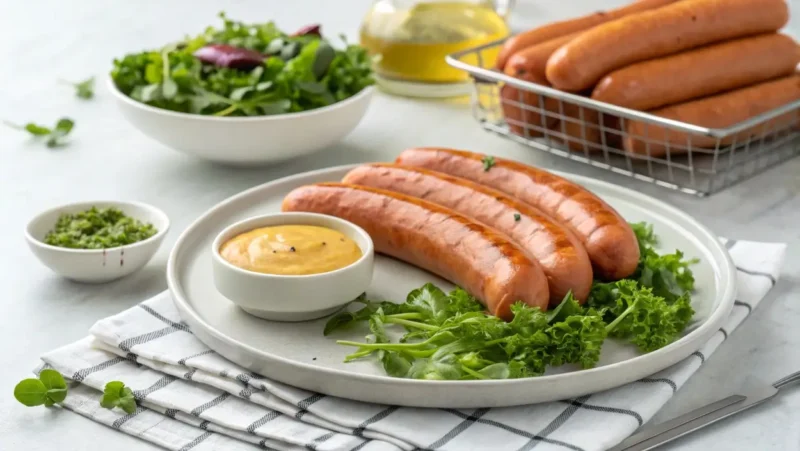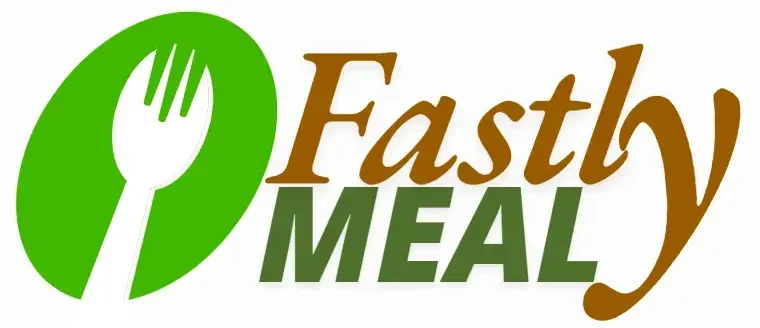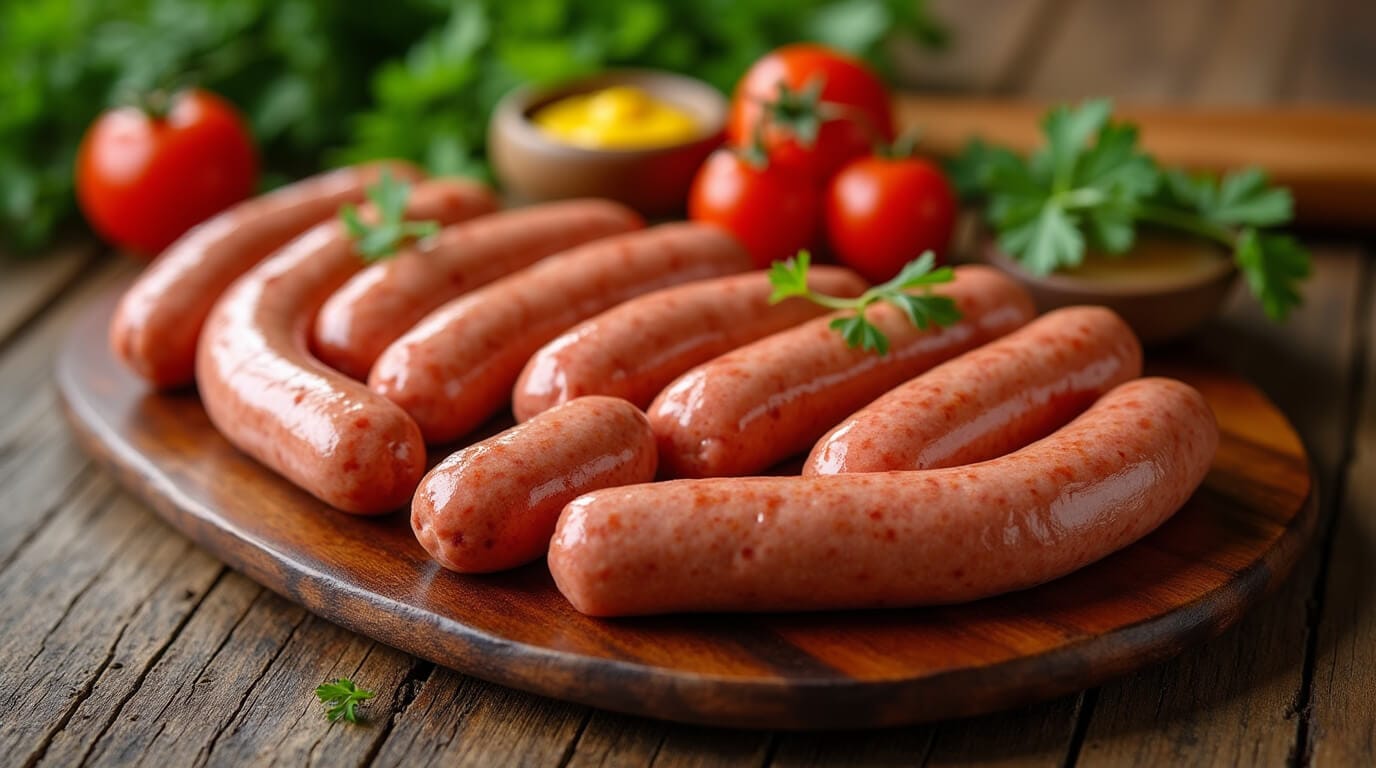Ah, the small but mighty snack that has graced shelves, picnic baskets, and kitchen pantries for decades. It’s compact, versatile, and bursting with potential. If you’ve ever wondered how something so unassuming can pack such a flavorful punch, you’re not alone. These tiny sausages are a testament to the saying, “Good things come in small packages.”
Whether you’re a die-hard fan or just Vienna sausage-curious, this guide will walk you through everything you need to know. We’ll uncover its history, unique attributes, and mouthwatering ways to enjoy it. Ready to dive in? Grab a fork (or toothpick) because we’re about to dig into all things Vienna sausage.
Table of Contents
What is it?
Vienna sausage is like the Swiss army knife of canned foods. It’s versatile, easy to store, and ready to eat straight out of the can. These small, slender sausages are typically made from a mix of meats, usually pork, beef, or chicken, blended with spices, then cooked and preserved in brine or broth.
Unlike traditional sausages, Vienna sausages are precooked, meaning no preparation is required. That’s what makes them a favorite for camping trips, quick snacks, and emergency food supplies. They’re the kind of thing you can grab when you’re too tired to cook but still want something satisfying.
If you’re intrigued by versatile meat dishes, you might also explore this smoked meatloaf recipe for another flavorful experience.
A Quick Look at the Origins
The name nods to its Austrian roots, specifically Vienna (Wien in German). But don’t let the name fool you, this isn’t a strictly European delicacy. Its modern version, especially the canned kind, is an Americanized take on the original Wiener Würstchen, which are traditional Viennese sausages served hot.
Fun fact: While the original Viennese sausages are enjoyed warm and with mustard in Austria, their canned cousins have become a global phenomenon. You’ll find Vienna sausage popping up in recipes from the Philippines to Puerto Rico!
Curious about why some cooked meats might look different? Discover why meatloaf might still be pink, offering insights into culinary science.
What Makes it Unique?
So, why does it have such a loyal following? It boils down to three things: flavor, convenience, and versatility.
Flavor Profile and Texture
Vienna sausages are mild yet savory, with a touch of smokiness that makes them stand out. Their texture is soft and tender, thanks to the fine grind of the meat mixture. Imagine a hotdog but smoother, smaller, and just as satisfying.
For more ideas on enhancing flavors in meals, discover Healthy, Yummy Chicken Apple Sausage Recipes Now.
Ingredients and Preparation
Typically, It contains a blend of pork, chicken, or beef seasoned with garlic, paprika, and other spices. It’s then cooked and sealed in a can with brine or broth. This preservation method not only enhances its shelf life but also allows the flavors to meld beautifully.
“The beauty of Vienna sausage lies in its simplicity, just open, eat, and enjoy.”
Types of Vienna Sausages
Not all Vienna sausages are created equal! Depending on where you live or shop, you’ll come across different variations that cater to various tastes and preferences.
Canned Vienna Sausage
This is the classic version most people know and love. It comes pre-cooked and packed in a convenient can, making it perfect for stocking up or traveling. Pro tip: The broth it’s packed in? Don’t toss it, it can add a savory kick to soups or sauces.
Fresh Vienna Sausage
Though harder to find, fresh Vienna sausages are a treat. These are typically made by local butchers or specialty shops and offer a firmer texture and richer flavor compared to their canned counterparts.
Specialty Flavors and Regional Variations
From spicy jalapeño-infused sausages to garlic-heavy Filipino versions, Vienna sausages come in countless regional variations. For example, some Asian brands even incorporate sweet flavors or curry spices to cater to local palates.
Cooking with Vienna Sausage
Vienna sausages are more than just a quick snack. With a little creativity, you can turn them into something truly special.
Breakfast Ideas

Start your morning with a Vienna sausage omelet. Simply slice the sausages into thin rounds, sauté them with onions and peppers, and fold them into fluffy scrambled eggs. Or go for an easy sausage-and-cheese breakfast burrito.
Creative Party Appetizers
Hosting a gathering? Wrap Vienna sausages in crescent roll dough to make bite-sized pigs in a blanket. Pair it with insights from dishes like chicken and shrimp recipes to craft a versatile menu.
Comfort Food Classics
Feeling nostalgic? Pair Vienna sausages with mac and cheese for the ultimate comfort meal. The smokiness of the sausage complements the creamy pasta perfectly.
“Cooking with Vienna sausage is like adding a shortcut to flavor, fast, easy, and always satisfying.”
Vienna Sausage Around the World
Did you know Vienna sausage isn’t just a pantry staple in the U.S.? It has traveled the globe and been embraced by countless cultures, each putting its unique spin on this versatile snack.
For an exploration of other global meat favorites, check out this summer sausage guide to learn about their cultural significance.

The Philippines
In the Philippines, Vienna sausage is often a breakfast favorite. Locals sauté it with garlic and onions and serve it alongside fried rice and a fried egg, a dish called silog. It’s a quick and affordable way to enjoy a hearty meal that fuels you for the day.
Puerto Rico
Puerto Rican cuisine incorporates Vienna sausage into arroz con salchichas, a savory rice dish cooked with spices, peppers, and Vienna sausages. This dish is a testament to how simple ingredients can create bold flavors when combined with care and tradition.
Eastern Europe
In countries like Poland and Hungary, Vienna sausage serves as an easy addition to stews or goulash, adding a smoky, meaty flavor that complements the hearty base.
“Wherever you are in the world, Vienna sausage seems to find its place at the table, proving its universal appeal.”
Popular Global Brands
From Libby’s and Armour in the United States to Purefoods in the Philippines, Vienna sausage brands cater to diverse markets. Each one tweaks its recipe to suit local preferences, whether that means adding spices, adjusting textures, or even using different meats.
Vienna Sausage vs Other Sausages
Is Vienna sausage the underdog of the sausage world? Let’s compare it to some of its bigger, bolder counterparts to find out.
Hot Dogs vs Vienna Sausage
At first glance, Vienna sausages and hot dogs might seem like siblings. However, Vienna sausages are smaller, softer, and more delicately spiced. While hot dogs shine on a grill, Vienna sausages excel in convenience, they’re ready to eat, no cooking required.
Bratwurst vs Vienna Sausage
Bratwursts are the hearty, grill-friendly sausages bursting with spices and herbs. Meanwhile, Vienna sausages are the portable, mild-mannered counterpart that fits perfectly into quick snacks and simple meals.
Why Choose it?
Vienna sausages are the go-to choice when convenience and versatility are key. Whether you’re camping, meal prepping, or just snacking on the go, they check all the boxes.
Tips for Buying and Storing
Want to get the most out of your Vienna sausages? Let’s talk about how to pick the best ones and store them for peak freshness.
How to Choose the Best
Pay attention to the label! Look for sausages made with higher-quality meat and fewer additives. Some brands offer low-sodium options, which are a great choice if you’re keeping an eye on your salt intake.
Storing Canned Vienna Sausage
Canned Vienna sausages are a prepper’s dream, they can last for years in a cool, dry pantry. Once opened, though, you’ll need to refrigerate them and use them within 2–3 days.
Shelf Life Insights
Wondering if that can of Vienna sausage in the back of your pantry is still good? Most brands include a “best by” date on the can. If stored properly, they often remain safe to eat for months beyond that date, though the quality may slightly decline.
“Vienna sausage: it’s not just shelf-stable, it’s life-stable!”
Health Considerations
They may be tasty and convenient, but are they healthy? Let’s break it down.
Nutritional Facts
A typical serving of Vienna sausage (about 4–5 small sausages) provides protein, fats, and some essential vitamins. However, they’re also high in sodium and preservatives, so moderation is key.
Balancing Sodium and Preservatives
One of the main concerns with Vienna sausages is their sodium content. If you’re on a low-sodium diet, look for reduced-salt options or pair them with low-sodium foods like fresh veggies.
Are They a Healthy Choice?
Like most processed foods, Vienna sausages are best enjoyed as part of a balanced diet. Treat them as an occasional indulgence rather than a dietary staple, and you’re good to go.
DIY Vienna Sausage

Want to elevate your love for Vienna sausage to a whole new level? Try making your own at home!
How to Make it at Home
Making homemade Vienna sausage is easier than you think. Start with a mix of ground pork and chicken, season it with garlic, onion powder, and paprika, then blend it to a smooth paste. Shape the mixture into small, sausage-sized logs and steam them until cooked through.
Choosing Ingredients
The best part about homemade Vienna sausage is that you control the ingredients. Want less salt? No problem. Prefer organic meat? Go for it!
Homemade vs Store-Bought
Homemade Vienna sausage may lack the long shelf life of its canned counterpart, but the flavor and freshness are worth the tradeoff. Plus, you can customize it to your heart’s content.
in Popular Culture
It isn’t just a beloved food item; it’s also a cultural icon. Over the years, these tiny sausages have made their way into films, music, and even childhood memories, creating a nostalgic connection that transcends generations.
Famous Mentions in Media
Vienna sausages have been referenced in movies, books, and songs, often symbolizing simplicity or comfort. In survivalist tales, they’re the ultimate no-frills food, and in comedies, they’re occasionally used for laughs, who hasn’t chuckled at someone eating them straight out of the can during a crisis?
A Nostalgic Comfort Food
For many, Vienna sausages are a reminder of childhood lunches, family camping trips, or quick snacks whipped up by grandma. It’s a food that feels like home, no matter where that may be.
“There’s something heartwarming about cracking open a can of Vienna sausages. It’s like unsealing a little slice of the past.”
Sustainability and Ethics
In today’s world, food choices come with ethical considerations. So, where does Vienna sausage stand when it comes to sustainability and production practices?
If you’re interested in creating more sustainable meals, this guide on leftover rotisserie chicken recipes offers great tips for reducing food waste.
Ethical Considerations in Production
Mass-produced Vienna sausages are often made from by-products of meat processing, which raises questions about animal welfare. However, some brands are making strides toward more ethical sourcing by using certified humane practices.
Sustainable Practices
Some companies now offer Vienna sausages made with organic or grass-fed meat, aiming to reduce their environmental footprint. By choosing these options, you can enjoy your favorite snack while supporting a more sustainable food system.
Frequently Asked Questions
Let’s answer some of the burning questions you might have about this iconic sausage.
Can Vienna sausage be part of a balanced diet?
Absolutely! While high in sodium, Vienna sausages can be part of a balanced diet when enjoyed in moderation. Pair them with fresh vegetables and whole grains to round out your meal.
How long can you keep opened Vienna sausage?
Once opened, canned Vienna sausages should be refrigerated and consumed within 2–3 days. Keep them in an airtight container to maintain freshness.
Are there low-sodium Vienna sausages?
Yes, many brands offer low-sodium or reduced-salt varieties. Check the label to find one that suits your dietary needs.
Can Vienna sausage be eaten cold?
Definitely! Vienna sausages are precooked, so they’re safe to eat straight out of the can. However, warming them up can enhance their flavor.
What are some easy Vienna sausage recipes?
From breakfast burritos to sausage stir-fries, the possibilities are endless. Slice them up and get creative in the kitchen!
Are there vegan alternatives to Vienna sausage?
Yes, several brands now produce plant-based Vienna sausage alternatives. They mimic the flavor and texture of the original while catering to a vegan diet.
The Versatility and Charm
Vienna sausage has earned its place in pantries worldwide, offering a unique combination of flavor, convenience, and nostalgia. These tiny, tender sausages, often packed in cans, boast a mild, smoky taste that appeals to diverse palates. Whether you enjoy them straight from the can or as part of a creative dish, their versatility shines.
Explore more creative and tasty ideas at Fastly Meal, your go-to source for culinary inspiration.
For quick snacks, pair Vienna sausage with crackers and cheese. Feeling adventurous? Incorporate them into recipes like stir-fries, soups, or casseroles to add a savory twist. They’re a reliable companion for outdoor adventures too, thanks to their portability and long shelf life.
Vienna sausage embodies comfort and practicality. It reminds us of shared moments around the table, where simple ingredients create lasting memories. So, next time you’re stocking your pantry, don’t overlook Vienna sausage, a small can with endless possibilities and plenty of delicious nostalgia waiting to be made.

